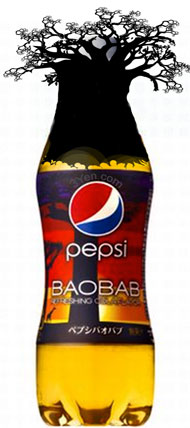The pomegranate is everywhere in Armenia. And I don’t mean just in the markets. A famous film is named after the fruit. Tea and wine are made from it. And its image features on everything from church walls to tourist souvenirs. I suppose it goes back to pre-Christian mythology, in which it was a symbol of fertility and abundance — something to do with the belief that each fruit contained exactly 365 seeds, perhaps. Anyway, here’s a compendium of pomegranate iconography from my recent trip. Couldn’t get much information on diversity, I’m afraid, how much there is of it and to what extent it is endangered. Something for the next time.
Armenian agrobiodiversity on sale
Բարի գալուստ Հայաստան!
Can one ever have too many factsheets on the baobab?

Fresh on the heels of Bioversity’s ‘African Priority Food Tree Species’ factsheet on the baobab, which was itself fresh on the heels of the Agroforestree database factsheet on the baobab, we now have, again from Bioversity, another, ahem, factsheet on the baobab. Well, this is different. I think. It’s part of a series on neglected and underutilized species. Or maybe nutritious and underutilized, as they are also described on the website. Maybe because it’s becoming difficult to call the baobab neglected. In fact, with the recent update of a review of the use of the species, perhaps the time has come for a meta-factsheet on the baobab.
Where the hell is Luigi?
For all those 1 who asked me where the Genetic Resources Institute is in Baku, here it is:
It’s a veritable oasis in the middle of urban sprawl, what with its various fruit tree collections all around the newly expanded building. The circular structure is where the regional conference on “Diversity, characterization and utilization of plant genetic resources for enhanced resilience to climate change” was just held.
Nibbles: Swaziland, Traditional Knowledge, Climate change, Apples, Winged beans, Ambakkadan Cassava
- Queen Mother Ntombi Indlovukazi of Swaziland receives the FANRPAN 2011 Food Security Policy Leadership Award. Her son’s a caution too.
- Summaries of presentations at Informing International Policy on Traditional Knowledge, Mexico 2011.
- CGIAR book on “climate-proofing” crops critical to food security in the developing world.
- Happy Birthday to the McIntosh apple.
- Rhizowen’s winged beans fail to take flight.
- Sharefair hears how women farmers in India resurrected a favoured cassava.
- Sharefair hears dream-team pitch on frike, or as we prefer to say, freekeh.